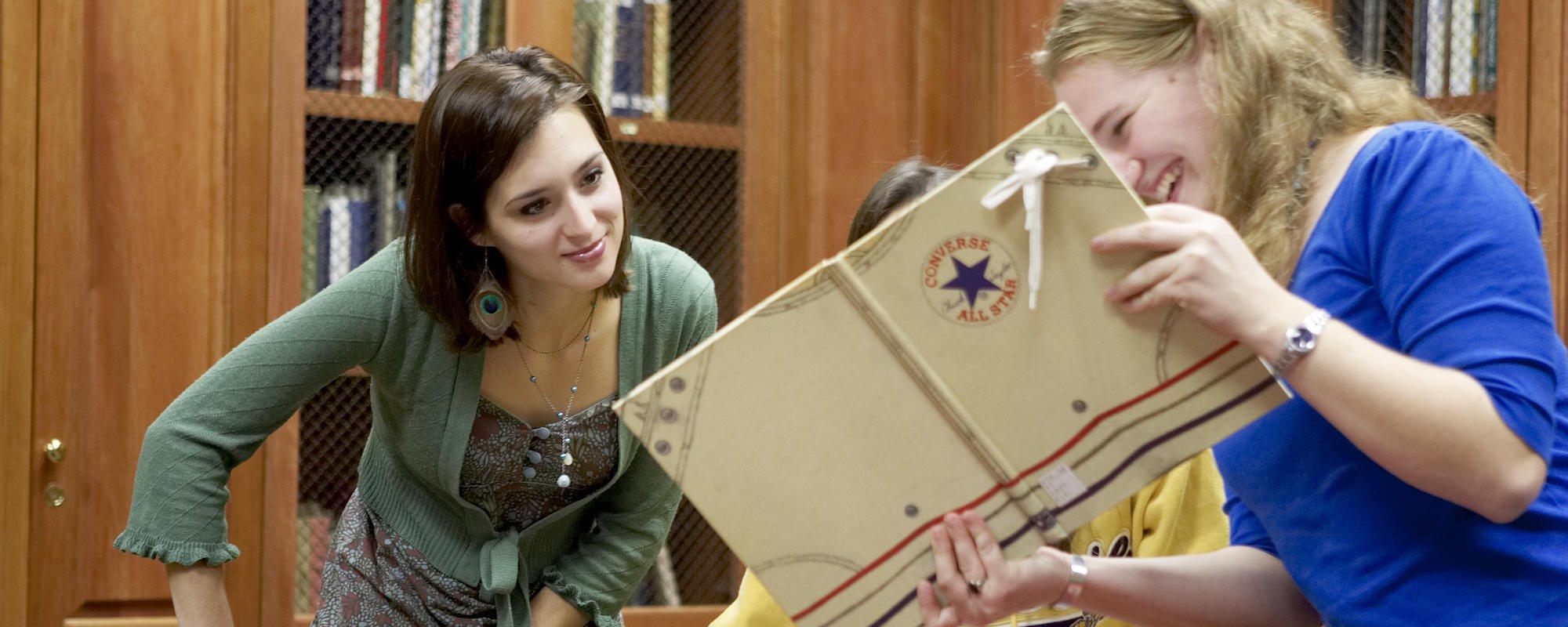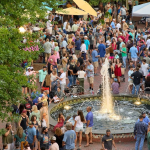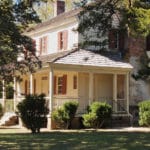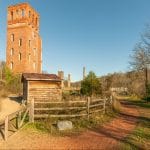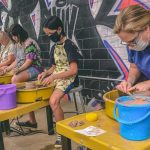The Scholar’s Tour of Spartanburg County
Historical documents often give researchers an understanding of the social history of a place and how residents interacted with one another in the past. Libraries are one of my favorite places to visit when I go to a new town. This type of historical preservation is a quieter more nuanced art and it tends to be overlooked by visitors. However, if you find yourself in Spartanburg yearning to learn more about the city’s history, there are several places to go, depending on your interests.
The Archives of Mickel Library at Converse College
 The top floor of Converse’s Mickel Library at 580 East Main Street houses the college’s archives, helmed by the knowledgeable Dr. Jeffrey Willis. He’s authored two books about the Upstate, the first a pictorial work about Spartanburg, and the second about Converse College’s history. The library’s special collections focus on the college’s early years, as well as documentation of the business holdings of Dexter Edgar Converse, the Vermont native that settled in Spartanburg before the Civil War and became a successful pioneer in the cotton mill industry. He is the investor that the college is named after. There are documents about Glendale Mills and the Clifton Manufacturing Company.
The top floor of Converse’s Mickel Library at 580 East Main Street houses the college’s archives, helmed by the knowledgeable Dr. Jeffrey Willis. He’s authored two books about the Upstate, the first a pictorial work about Spartanburg, and the second about Converse College’s history. The library’s special collections focus on the college’s early years, as well as documentation of the business holdings of Dexter Edgar Converse, the Vermont native that settled in Spartanburg before the Civil War and became a successful pioneer in the cotton mill industry. He is the investor that the college is named after. There are documents about Glendale Mills and the Clifton Manufacturing Company.
The collection is strongest in the photographic documentation of early college traditions and former landmarks on the women’s college campus. However, it is important to note that three are a number of maps of South Carolina dating back as early as 1726. Another map I found to be of interest is a pre-Civil War geographical, statistical, historical Map of South Carolina that listed the number of whites, slaves and free blacks in different districts, like Greenville and Spartanburg counties.
The Converse archives also include information about Harriet Quimby (1875-1912), an early American aviator and a movie screenwriter. In 1911, she was awarded a U.S. pilot’s certificate, becoming the first woman to gain a pilot’s license in the United States. Spartanburg military historian Ed Y. Hall developed this collection while working on the biography entitled “Harriet Quimby: America’s First Lady of the Air.” There is a significant collection of research papers, news articles, photographs, and other documents concerning Harriet Quimby’s life and accomplishments.
The Kennedy Room at the Spartanburg County Public Library
 Spartanburg’s public library been around since the 1880s and it prides itself on being the go-to resource for local government history and family genealogy. There’s an oral historian on staff, and archivist Brad Steineke is well versed in Spartanburg’s architectural and photographic holdings. The archives, located at 151 South Church Street, also hold collections donated by local families. The largest of all these is the DuPre Moseley collection. The family has deep local roots and one of its recent descendants, Carlos Mosley, was the managing director of the New York Philharmonic. His correspondences with composers and musicians like Leonard Bernstein and Pierre Boulez are here, as well has his ancestors’ letters home when they were Naval officers serving during the Civil War.
Spartanburg’s public library been around since the 1880s and it prides itself on being the go-to resource for local government history and family genealogy. There’s an oral historian on staff, and archivist Brad Steineke is well versed in Spartanburg’s architectural and photographic holdings. The archives, located at 151 South Church Street, also hold collections donated by local families. The largest of all these is the DuPre Moseley collection. The family has deep local roots and one of its recent descendants, Carlos Mosley, was the managing director of the New York Philharmonic. His correspondences with composers and musicians like Leonard Bernstein and Pierre Boulez are here, as well has his ancestors’ letters home when they were Naval officers serving during the Civil War.
The Kennedy Room holds a significant cache of government records and microfilm records—court records, military records, vital statistics, and things of that nature. Some of the records date to when Spartanburg County was created in 1785, and the collection ends around 1900.
The archives have a strong collection of historical pamphlets which provide biographical information on high-profile Spartanburg residents, as well as foundational history of smaller towns in Spartanburg County, like Pauline and Glenn Springs. The library also keeps a number of church records. In the 1960s the library acquired 500 photographs taken during the 1880s-1940s by Aldred Willis. From there the library acquired more photographs. The Pizzimenti and Bradford Collections are notable, and include pictures from World War II. It is the strong aerial photograph collection dating from the 1940s to the 1990s that truly sets SCPL apart, and it’s a resource that few other institutions can match.
Archives and Special Collections at USC Upstate
 The collection at USC Upstate is the youngest of the bunch, and the university will celebrate its 50th anniversary in 2017. With 6,000 enrolled students, it’s the largest of the USC extended campuses. The school was founded to train nurses, and the archives echo that focus. Archivist Ann Merryman states that there is an emphasis on institutional history, healthcare, education, military history, and religion (with the exception of Methodism, which is highly sought after by Wofford College).
The collection at USC Upstate is the youngest of the bunch, and the university will celebrate its 50th anniversary in 2017. With 6,000 enrolled students, it’s the largest of the USC extended campuses. The school was founded to train nurses, and the archives echo that focus. Archivist Ann Merryman states that there is an emphasis on institutional history, healthcare, education, military history, and religion (with the exception of Methodism, which is highly sought after by Wofford College).
Many of the recent acquisitions focus on the ten-county area known as the “upstate.” Because the collection is so young, there’s an eclectic mix of volumes from the early 19th century—the cohesive thing about these books are the dates that they were published. Books of Celtic lore find their place next to original German works. There is a copy of the biography of the signers of the Declaration of Independence from 1820 not far from the works of William Gilmore Simms, a prolific writer and editor from South Carolina.
The Thomas Moore Craig Collection of Southern History and Literature has several rare holdings, including the 1847 third printing of the “Southern Harmony and Musical Companion,” a shape note song book by William Walker, a resident of Spartanburg known as “Singing Billy.” Other holdings at the library include a lithograph of John C. Calhoun and newspapers donated by locals about historic events, like the assassination of President Kennedy and the invasion of France during World War II.
Archives and Special Collections in Sandor Teszler Library of Wofford College
 Wofford’s holdings are so vast that they were split into two sections. There’s the Wofford Archives, which holds the permanent records of the college and the records from the South Carolina Methodist Conference. This is where researchers and curious visitors will find most of the information about Methodist churches in South Carolina. The other half of the archival space, known as Special Collections, is carefully cared for by archivist Luke Meagher. He considers himself to be a historical generalist, but he is knowledgeable about the library’s holdings and the archive’s genesis.
Wofford’s holdings are so vast that they were split into two sections. There’s the Wofford Archives, which holds the permanent records of the college and the records from the South Carolina Methodist Conference. This is where researchers and curious visitors will find most of the information about Methodist churches in South Carolina. The other half of the archival space, known as Special Collections, is carefully cared for by archivist Luke Meagher. He considers himself to be a historical generalist, but he is knowledgeable about the library’s holdings and the archive’s genesis.
The rare books collection began when retiring professors donated their book collections to the college. James Carlisle, an early math and religion professor who died 1909, is the source for most of the math and history texts from the 19th century. The archives hold a number of books and religious texts from the 1500s to the 1700s, and the most recognizable of these without a doubt is “The Collected Works of Chaucer.” It was printed in the 1550s and came to Wofford in 1835. The collection also contains a number of maps from the early 1800s to Reconstruction.
 The college recently acquired the notebook of a slave trader by the name of William James Smith, and the collection has a number of items tied to the Antebellum South. Also of note are the thousands of stereographs, which were turned into an exhibition in the Sandor Teszler Library Gallery. The archivist worked with students to digitize specific images and make them 3D so that the audience could use cyan and red glasses that enhance a viewer’s experience.
The college recently acquired the notebook of a slave trader by the name of William James Smith, and the collection has a number of items tied to the Antebellum South. Also of note are the thousands of stereographs, which were turned into an exhibition in the Sandor Teszler Library Gallery. The archivist worked with students to digitize specific images and make them 3D so that the audience could use cyan and red glasses that enhance a viewer’s experience.
Wofford also holds the Broadus Littlejohn Jr. Collection and the Littlejohn family papers. Broadus (affectionately known as Dick) was a Spartanburg native and Wofford graduate. His family owned the Community Cash grocery stores and he was a private collector of historical memorabilia, with an interest in Southern history. His papers include a land agreement created by Daniel Boone in 1797, correspondences from Benjamin Harrison and John Jay, as well as a couple of colonial documents dating from 1748. The library’s other holdings include cultural heritage items that will peak a researcher’s interest.
Latria Graham, Produced in cooperation with the HubCity Writers Project.
 Latria Graham is writer, editor and cultural critic currently living in Spartanburg. Her interests revolve around the dynamics of race, gender norms, class, nerd culture, and—yes, football. You can find out more about her here.
Latria Graham is writer, editor and cultural critic currently living in Spartanburg. Her interests revolve around the dynamics of race, gender norms, class, nerd culture, and—yes, football. You can find out more about her here.


